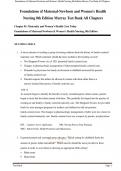Exam (elaborations)
Foundations of Maternal-Newborn and Women's Health Nursing 8th Edition Murray Test Bank All Chapters
- Course
- Institution
Foundations of Maternal-Newborn and Women's Health Nursing 8th Edition Murray Test Bank All Chapters
[Show more]




